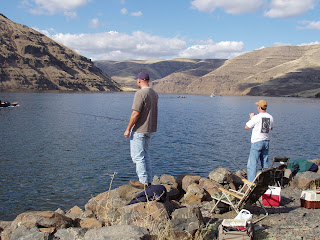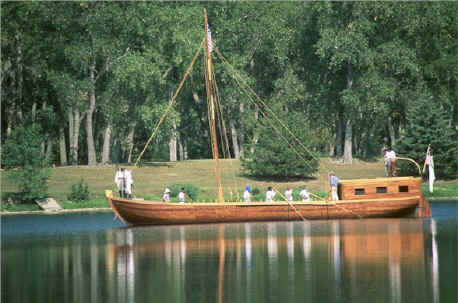Chapter 1: Courage ...
Maybe he was gruff, but then
Ranger, sitting at Norman
I felt a little foolish, a 60 year old white guy who had started on the Red Road Norman
A little testy myself, I replied,“Courage would be unnecessary without fear.” My thought was that the notion of courage wouldn’t even make sense without fear, but phrased the reply more indirectly partly out of respect for the seriousness of the situation and partly to avoid the implied jab at the traditions and at Norman
I had just made the four ceremonial presentations of the pipe I carry; Norman
Norman moved back to business with his asking of the traditional question, “Brother, what is your vow?”
I had given the proper ritual response, “To offer myself on the mountain for the next four days.” Norm grunted approval. Ranger looked pensive; he tuned back in now that we had returned to a proper ceremonial exchange. He logged my pledge into his memory.
Norman moved back to business with his asking of the traditional question, “Brother, what is your vow?”
I had given the proper ritual response, “To offer myself on the mountain for the next four days.” Norm grunted approval. Ranger looked pensive; he tuned back in now that we had returned to a proper ceremonial exchange. He logged my pledge into his memory.
“Oh brother,” Norman offered, “we all have our fears. Some of us are afraid of dark or animals, or of being alone.”
I was a little annoyed, partly at myself for having ever entered the Sioux world of “suffering for the people,” but also at Norm’s assumptions about my fears. His words spoke to children’s fears and I do not have these.
A little gruff now myself, I replied, “I’m not afraid of dark and I usually enjoy being alone. Although I have great respect for the strength of many animals, I have no fear that they will come into my vision quest alter and harm or eat me. Well actually, I do have great fear of polar bears. I always carried a .44 on my walks one January when I was in polar bear country. They are land sharks."
Norm grunted softly, “ah ho,” which usually meant agreement. I took this to mean that he shared my view of polar bears.
“Polar bears are the only animals that actively hunt humans systematically,” I went on, “but we are in the mountains of southern British Columbia and there are no polar bears here, so that is not my fear.”
Norm waited, and although Ranger had concluded hi job as witness, he looked a little more interested in the turn in the conversation.
“Norman Texas
“When I moved to the Northwest 25 years ago, I had two choices my first real winter. I could crouch for three months in my house, car and office; or, I could learn to live outside in the cold.”
“So, I learned about winter survival. Stay dry and warm. If you should by some accident get wet, build a large fire, strip naked and dry out before proceeding. Wear light layers of polypropylene, wool, down and Goretex. Don’t sweat! Avoid this by removing layers of clothing to your pack when you are warm and add some of these back when you begin to feel chill. Sleep in dry down or some approximation to that. Always have cap and gloves handy. And, an extra pair of dry socks. Stay hydrated. Load your body with fats and carbs before you start out. Carry emergency food – a stash of candy, nuts, and other good concentrated calorie reserves. Eat these regularly if you will be out for a day or so. Have the ability to make a fire – for emergencies and to make your camp or bivouac more comfortable over night – even with wet frozen wood.”
Both Ranger and Norm looked interested, but as if they wondered exactly where this little outburst of mine was going. I took the hint and moved directly back to my fears.
When I continued, “It snowed last night just up the mountains about 1000 feet above us,” they both nodded. Said they had noticed that when they had walked from the community encampment to the ceremonial lodge this morning. But then it was BC, the CanadianRockies , and early May. The weather could do most anything for the next month. There was no “ah ho” this time. The snow was there for anyone to see. These guys grew up here and wondered just what the hell was my point.
When I continued, “It snowed last night just up the mountains about 1000 feet above us,” they both nodded. Said they had noticed that when they had walked from the community encampment to the ceremonial lodge this morning. But then it was BC, the Canadian
So I went on, “I just made a pledge which means that I’ll walk up on that mountain in nothing but gym shorts, moccasins and a blanket; and and, I'll sit up there in a ceremonial space 6 feet square for four days and nights. Also, the pledge requires that I will have no food, no water for the 96 or so hours.” “Nothing by mouth” as Melvin had phrased the rule after that first Hamblecheya at Bear Butte five years ago. He was giving me a caution and mild rebuke over my report of an unwitting rule violation – I had lain on my back with mouth open to the brief rain shower on my third day and eaten a couple of the “mosquito people” on the fourth. I had thought that if they had my blood in them, it was only justice that I should eat them. Melvin had explained patiently that you must kill nothing on Hamblecheya. Anything that comes into your alter space, whatever its outer form, may be the grandfathers coming to talk with you with guidance and warnings. This contact with the spirit world was one of the prime goals of the vision quest -- to get guidance. The spirits did not always bless the fasting seeker which is the reason that traditional speakers sometimes translate Hamblecheya as Crying for a vision. Indeed, many fasters cry out for a vision during the four day ordel.
Warming to the topic of my anticipated deprivations, I continued, “At least as bad as the food part, is that I cannot smoke cigarettes for the four days, and I am a nicotine addict.” I realized that having to abstain from this bad habit was really a “side fear,” anxiety really, so I dropped the topic and returned to the main fear -- cold.
“If the weather is normal for this time of the year, we’re going to see rain, snow, wind, sun, mosquitoes, but most especially, (I paused) cold at night. Around nine in the evening, a “snow wind” develops; air cooled by snow at higher elevations slides down the mountain through the vision quest sites, on down to the community encampment and to the Cold Water River
Finally to my point, “What I’m doing over the next four days violates every winter survival rule that I have learned. I will do it, I emphasized, because I made a pledge to do it, but it scares the shit out of me.”
Really nothing else to say. As I moved toward the door, Norman
If I were a Christian or Muslim, my feelings at that moment would no doubt be called a “crisis of faith,” a rather serious crisis of faith. I was not at all certain that the prayer pipe would protect me from freezing to death, frostbite at least; nor was I certain that the Grandfathers would see over me. I had not been reared in the Lakota path; only encountering it five years ago when I was drawn into the circle to learn and practice the traditions. Initially, it was probably mostly curiousity. Came to study; stayed to pray.
Bottom line is that the vow had been given and must be fulfilled.
The extraordinary became ordinary.
Habit and ritual kicked in.
Slipped into some shorts and grabbed a towel for the purifying sweatlodge. Hoisted the duffel bag with ceremonial items I would need -- star blanket, tobacco flags and ties, abolone shell, spiritual offerings. Locked the truck and proceeded to Sweat Lodge.
The whole community joined in the lodge. Afterwards, I dried, changed to a breach clout (my only clothes) and took up the Star Blanket (my only covering from the cold).
The "Quest" went normally if there is such a thing. Cold nights, hot days, rain, spot of snow, mosquitoes. Four days. Hunger was worse the second day, but hunger goes away by the third day and is not really notieable by the fourth. I really missed cigarettes, but the rule is, "Nothing by mouth." But I missed water much more intensely. Thirst grew over the first day and night. By the second day dehydration was serious. The third day without water was a genuine ordeal -- I considered giving up, cutting and running. But I could not. The vow had been given and must be honored -- else I would have no honor among the Sioux.
Water. On the fourth day my mouth was so dry my toungue stuck to the roof of my mouth. I could not talk, there was no saliva, no spit. By this time hunger, fatigue, sleeplessness, had slipped out of focus. All I could feel was thirst. I waited out the final day. Norman and helpers came for me. We went down from the mountain, entered a sweat lodge where I was given delicious sips of water and dilute chokecherry juice to restart kidney function. Afterwards, some bland food -- potato soup.
My vow fullfilled, I pretty much forgot about "courage" and Norm's embarrassment when I had mentioned my fears. Didn't really think about it again until the Sundance the following month.
Melvin Graybear supervised the Sundance each year near Poplar, Montana. Those of us planning to dance met with Melvin before the dance. Seated on the ground in a semicircle around the sacred tree, we listened to Melvin as he gave instructions and rules for the dance that year.
It was also Melvin's habit to explain Lakota ways and virtues at this time. The virtues are straightforward -- honesty, generosity, courage, humility .... Melvin clarified these much in the manner of a minister's topic for a sermon. One year a brother had had some problems with "honesty." So, Melvin's explication of this was, "Honesty: Do not lie, cheat of steal."
This year, Melvin paused a moment when he came to "courage." Looking directly at me, he said,
"Courage: ... Not to express fear."
Suddenly, I realized that my Wasichu notion of courage was not the same as the Lakota notion. While I honored my vow, I had indeed mentioned my fears. At the feast after the dance, I asked Melvin why the expression of fear was so important. He replied, "Brother, expressed fear can be contagious." Ah ho!
"... not to express fear."















































